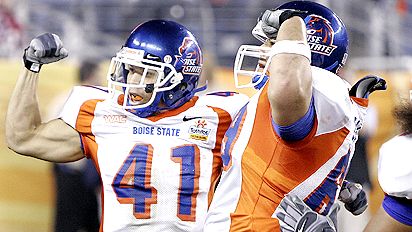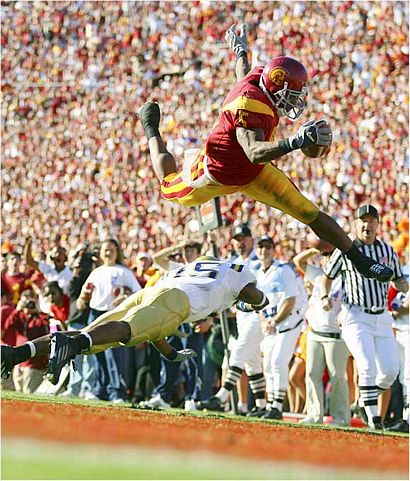 Complete Bowl Picks
Complete Bowl PicksThe Matrix and the folks in Vegas don't seem agree about the BCS matchups. In most cases here, I take the side of the folks in Vegas.
Rose Bowl. Illinois vs. USC
If Illinois were to win this game, they might start next season in the top 5 and Ron Zook would be elected governor of Illinois. The only offense of note in this game is Illinois' run game which will face up against the 2nd most efficient run D in the country. The Illini, though, already beat the 3rd ranked run defense (the Ohio State). Mendenhall is as good of a runningback as any in the country and Juice is another dangerous running back who throws the ball more than most. USC, though, also touts a tough running game that now, in the form of Joe McKnight, is showing a little more explosiveness. USC is the better team and is essentially playing at home, but they don't have the fire power to put Illinois away.
The Matrix - USC by 8.3, 39.8% against the spread Sugar Bowl. Georgia vs. Hawaii
 All season, I wanted this mediocre Hawaii team to lose so they wouldn't get to this point and embarrass the non-BCS fraternity. Hawaii is undefeated because they have played the 105th toughest schedule in the nation - they beat Louisiana Tech by 1, got lucky against San Jose State and have a loss against Nevada in my unofficial record keeping. They are a better team when Colt is on the field, but who's to say Georgia won't get a couple of solid hits and knock him out of the game in the 1st quarter. And QB Colt Brennan will take his shots, because Hawaii has no running game and the Georgia lineman can pin back their ears and speed rush. Georgia's pass D is not spectacular, but it has the speed in the secondary it needs to contain Hawaii's receivers. On the other side, watch RB Knowshon Moreno to have a big game. He is in my RB top five (with McFadden, Charles at Texas, Patrick at OU, and UCF's Kevin Smith). I'm not as impressed with Georgia as others, but I think they have the speed to be where the Hawaii players are and the strength to put them down once they get there.
All season, I wanted this mediocre Hawaii team to lose so they wouldn't get to this point and embarrass the non-BCS fraternity. Hawaii is undefeated because they have played the 105th toughest schedule in the nation - they beat Louisiana Tech by 1, got lucky against San Jose State and have a loss against Nevada in my unofficial record keeping. They are a better team when Colt is on the field, but who's to say Georgia won't get a couple of solid hits and knock him out of the game in the 1st quarter. And QB Colt Brennan will take his shots, because Hawaii has no running game and the Georgia lineman can pin back their ears and speed rush. Georgia's pass D is not spectacular, but it has the speed in the secondary it needs to contain Hawaii's receivers. On the other side, watch RB Knowshon Moreno to have a big game. He is in my RB top five (with McFadden, Charles at Texas, Patrick at OU, and UCF's Kevin Smith). I'm not as impressed with Georgia as others, but I think they have the speed to be where the Hawaii players are and the strength to put them down once they get there.The Matrix - Georgia by 3.7, 33.1% against the spread
Fiesta Bowl. West Virginia vs. Oklahoma
These two teams would be playing in the national championship game but they suffered freakish upsets when their quarterbacks got knocked out. West Virginia was hit the hardest, because they lost in the very last game to a rival and because they have fewer opportunities to win titles than OU. Now, after being kicked in the gut, Rich Rodriquez has gutted the coaching staff. Pat White will have some time to recover from bruisings, but WVU, a 1-dimensional run offense, will be facing one of the nation's best run defenses. To make matters worse, by the end of the season OU's offense was as effective as as I've seen all year. QB Bradford rarely lets the ball touch the ground or an opponent, and OU's stable of NFL running backs runs through holes opened up by a dominant O-line. And Stoops is a better coach than whoever WVU will be able to pick out from the pee-wee league. Personally, I have loved watching WVU for the last two seasons and hope them the best after Rich jumped ship, so I hope they can at least keep this game close for the first half. If the game stays reasonably close, this will be the game to watch this bowl season.
The Matrix - Oklahoma by 1.2, 35.1% against the spread
Orange Bowl. Virignia Tech vs. Kansas
 I agree with everyone else that Missouri, not Kansas, should be in this game. But here's why Kansas is good: QB Todd Reesing has completed more than 60% of his passes for 3200 yards. The human sledgehammer RB Brandon McAnderson has rushed for over 1,000 yards, averaging 6 yards per carry and scoring 16 times. And they have a top 10 defense in adjusted yards per play. Watching the game, I was convinced that Kansas was better than Missouri, but made rare mistakes that cost them the game (and, therefore, Missouri should be in this game). I've only watched two Hokies games in their entirety, and one of those was the slaughtering LSU put on them, so my impressions maybe skewed. But Virginia Tech's "stifling" defense has only managed to stifle two offenses worth noting (BC and Clemson) and Kansas will bring in the best offense they have seen all season. And Virginia Tech will struggle against a Jayhawk defense that has allowed fewer opponent-adjusted yards per play than the Hokies own. It is also significant that Kansas has no significant injuries. On the other hand, Kansas has won all year against inferior opponents with inferior talent and Virginia Tech's speed may be their undoing.
I agree with everyone else that Missouri, not Kansas, should be in this game. But here's why Kansas is good: QB Todd Reesing has completed more than 60% of his passes for 3200 yards. The human sledgehammer RB Brandon McAnderson has rushed for over 1,000 yards, averaging 6 yards per carry and scoring 16 times. And they have a top 10 defense in adjusted yards per play. Watching the game, I was convinced that Kansas was better than Missouri, but made rare mistakes that cost them the game (and, therefore, Missouri should be in this game). I've only watched two Hokies games in their entirety, and one of those was the slaughtering LSU put on them, so my impressions maybe skewed. But Virginia Tech's "stifling" defense has only managed to stifle two offenses worth noting (BC and Clemson) and Kansas will bring in the best offense they have seen all season. And Virginia Tech will struggle against a Jayhawk defense that has allowed fewer opponent-adjusted yards per play than the Hokies own. It is also significant that Kansas has no significant injuries. On the other hand, Kansas has won all year against inferior opponents with inferior talent and Virginia Tech's speed may be their undoing.The Matrix - Virginia Tech by .8, 43.1% against the spread
National Champion Game. Ohio State vs. LSU
I was thinking I would make a special blog entry for this game or do something to set it apart until I remembered that I don't actually care all that much about this game. These two teams deserve to be in this game, but this season will go down with 1990 and 1984 as seasons in which a national champion was named only because we feel compelled to name a national champion - not because any team merited the title.
This hogwash about Ohio State not being able to deal with a mobile quarterback is, well, hogwash. Ohio State has a solid defense with real athletes. Only one team broke 20 against the Buckeyes this year, and Illinois (who managed 28, 32 less than Arknasas against LSU) are not similar to LSU in style. And Tressel & Co. can have the athletes to game plan in the two weeks they have running up to the game - and they can watch film on what 13 other teams have tried to stop Crowton's very undynamic offense.
The real story, in my opinion, for this game is going to be the health of LSU. Here is the injury report for LSU from NOLA.com:
Linebacker Darry Beckwith (12/3, right ankle) is probable for the BCS National Championship on 1/7 against Ohio State. Running back Trindon Holliday (12/3, ankle) is probable for the BCS National Championship on 1/7 against Ohio State. Wide receiver Early Doucet (12/3, shoulder) is probable for the BCS National Championship on 1/7 against Ohio State. Quarterback Ryan Perrilloux (12/3, finger) is probable for the BCS National Championship on 1/7 against Ohio State. Quarterback Matt Flynn (12/3, shoulder) is probable for the BCS National Championship on 1/7 against Ohio State. Defensive tackle Charles Alexander (12/3, knee) will miss the BCS National Championship on 1/7 against Ohio State. Guard Will Arnold (12/3, viral infection) is questionable for the BCS National Championship on 1/7 against Ohio State. Left tackle Mark Snyder (12/3, knee) will miss the BCS National Championship on 1/7 against Ohio State.
That's a long list and includes a lot of critical contributors. LSU has better athletes and was dominant before injury slimmed their ranks, and will win if they have their team back.
The Matrix - Ohio State by 1.9, 73.3% against the spread















